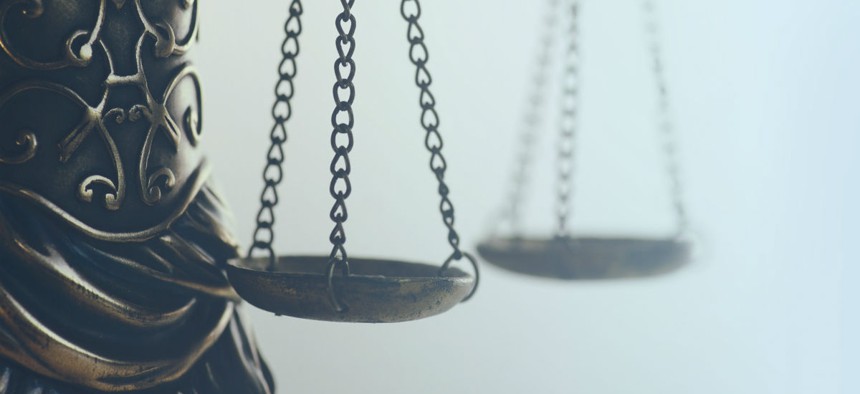
By BCFC / Shutterstock.com
Judges Fixate on Jurisdictional Question in Appeal of Decision Invalidating Trump Workforce Orders
The Justice Department has argued that federal employee unions’ efforts to unravel a series of workforce executive orders must first go through the Federal Labor Relations Authority.
During oral arguments Thursday for the Trump administration’s appeal of a court ruling invalidating the key portions of the president's executive orders targeting federal employee unions, judges spent most of their time focused on one issue: whether they are even allowed to hear the case.
In May 2018, President Trump signed three executive orders designed to make it easier to fire federal workers, streamline and limit the scope of collective bargaining negotiations, and significantly reduce the amount and activities eligible for union "official time."
Unions quickly sued in U.S. District Court, arguing that the president lacked the authority to issue the orders and that they violated the 1978 Civil Service Reform Act that codified collective bargaining in the federal workplace. U.S. District Judge Ketanji Brown Jackson last August agreed, finding that taken together, the orders’ key provisions amounted to an effort to “eviscerate the right to bargain collectively” at federal agencies.
The administration appealed that ruling to the U.S. Court of Appeals for the District of Columbia. The Justice Department has consistently argued that the district court and now the appeals court lack jurisdiction to hear the case, because the issues involved are within the purview of the Federal Labor Relations Authority.
Joseph Busa, an attorney representing the Trump administration, said the lawsuit was an attempt by unions to perform an “end-run” around the proper process for objecting to actions taken in collective bargaining, which is filing an unfair labor practice complaint with the FLRA.
After the executive orders were issued, "disputes erupted in concrete bargaining contexts, with questions like are [agencies] bargaining in bad faith or are they refusing to bargain over negotiable subjects?” Busa said. “But instead, plaintiffs went to district court and obtained injunctions with allegations that implementing the provisions of the orders will violate various enumerated sections of the statute. Those types of claims have to proceed under the [FLRA].”
The three-judge panel pressed Busa on that notion, noting that the original lawsuit was a “facial challenge” to the executive orders and named Trump as a defendant.
“They can’t bring a claim before the FLRA against the president,” Circuit Court Judge A. Raymond Randolph said.
“Well, I don’t think that’s quite right,” Busa said. “We cite in our opening brief that when a supervisor orders an unfair labor practice, then that’s an [unfair labor practice under the FLRA].”
“But the case here is against the president of the United States,” Randolph said. “Unions can’t bring a claim before the FLRA that is against the president of the United States . . . Franklin v. Massachusetts holds that the president is not an agency within the meaning of the Administrative Procedures Act and the jurisdiction of this agency is over agencies.”
“But they can gain precisely the relief that they want [before the FLRA],” Busa responded.
“That’s a different question,” Randolph said.
Andres Grajales, an attorney representing labor unions, faced similar questioning. He argued that because the executive orders seek to establish governmentwide rules that are not subject to collective bargaining negotiations, the FLRA cannot weigh in on their validity, so any review by that agency would be deficient. And he noted that the agency does not hear each case that it receives: the general counsel can simply determine a case lacks merit and effectively table it.
“Not every FLRA action yields a final order,” Grajales said. “The statute vests the general counsel with discretion about whether to bring an unfair labor practice complaint [to the full board]. It’s not just that you file a complaint and get a review. It gives discretion, and if the general counsel looks at the government’s argument and says, ‘Oh, this is a governmentwide rule,’ then no complaint may get issued.”
“Isn’t that just a consequence of the scheme [established by Congress]?” Judge Thomas B. Griffith asked.
“We’re outside of the scheme,” Grajales responded. “The action of the president is not something that Congress intended to channel through the scheme. There are other cases where this court has acknowledged that if unions want review of an [Office of Personnel Management] regulation, that proceeds in district court . . . These types of facial challenges to what essentially is in its nature a legislative rule belong in district court.”
Greg O’Duden discussed the merits of the case on behalf of the unions, and said that the ability to create governmentwide rules that are not subject to collective bargaining negotiations is not intended to take away core aspects of bargaining itself.
The government is using governmentwide rules "as its justification for taking aim at many collective bargaining provisions that have been taken off the table,” O’Duden said. “There’s caps on official time, curtailing bargaining about office space, and it purports to unilaterally end the practice of providing official time to union representatives helping people subject to grievances, all under the umbrella of governmentwide rules. But governmentwide rules cannot be just used to undo the core of the statute unilaterally by the president.”
“Why not?” Rudolph asked. “The whole collective bargaining scheme resulted from a [President John F.] Kennedy executive order, and before the statute the president could control what was allowed and what was not allowed in collective bargaining. And the statute specifically says that the power of the president that existed before Congress passed the statute is not affected by the statute.”
“That provision merely means that to the extent there are residual powers that the president retains post-enactment, he keeps them,” O’Duden said. “It doesn’t mean he gets to resurrect himself and return to the executive order regime that was in place before the statute."







